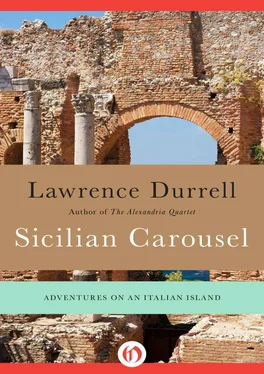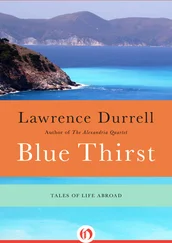The imaginative jump is a big one; but it is not less of a jump to try and imagine what the landscape must have been like without most of the fruit and flowers that we see today and which characterize our notions of the Mediterranean scene. So much of what surrounds us today came to the island very late in its history, sometimes as late as the sixteenth century. The long straggly hedges of prickly pear came from the Americas, as did the agave and the tomato. The Arabs imported lemon, orange, mulberry, and sumac. Papyrus from Egypt still flourishes in some corners. The land is bounteous, and it varies in exposure and elevation to a considerable degree. But then, if one reflects, even the olive and the vine were originally not native to Athens, though where they came from we can only conjecture. But as for Sicily, everything “takes” and there is a suitable corner where soil and temperature combine to welcome almost everything. Deeds had seen tobacco as well as avocado doing well here.
Indeed a stable subtropical climate is ideal for all crops — if one wishes to enjoy the best of all worlds. Here, for example, one can see stands of banana, grapefruit, and sugarcane in the hot lowlands. Even carob trees must have come from somewhere like the Lebanon.…
But how hard it is to imagine this “granary of Rome” without lemons, oranges, or grapes, without the cactus and the sentinel aloe. While in the cool misty uplands the conifers and berries remind one of Austria or England. Even the sweet orange was brought here from China by the Portuguese in the sixteenth century.
Is it any wonder that the Sikels, eking out a fearful life without all these glorious fruits in which to exult, left us nothing to admire? Not for them the final conquest of the land which brings wheat and barley, nor the control of the sea which brings the produce of other lands, other cultures to one’s door. They were locked up in their loneliness like the inhabitants of another planet and it is impossible to feel much sympathy with them, or gain any insight into their characters.
But if the arrival of the Greeks so much marked agriculture and city growth it was, so to speak, only the historical topsoil which was changed; underneath it all the island climate was that of Attica or perhaps the Argolid. The limestone valleys were quick with freshwater springs; the land was as beautiful as Greece and quite as rich. And in the first spring showers Sicily must have put forth as rich a crop of wild flowers as Attica itself for it still does to this day. The Greek garden described by Homer in the Odyssey —it could and perhaps did flourish also here in Sicily:
In this garden flourish tall trees like pears, pomegranates and apples thick with fruit, also sweet figs and bounteous olives. Moreover, a rich vineyard has been planted hard by, beyond the last row of trees; there are garden plots also blooming all year round with flowers.…
These new and picturesque additions to the domestic scene spelt leisure and plenty, and with them came the first thrust of the vase paintings and the first verses of the poets who peopled the streams with nymphs, the oak groves with dryads, the caves with Pans and centaurs, and the forests with satyrs and silens. In the culture which followed each plant and flower had its story, its link with the mythopoeic inner nature of man — which he can only realize when he has a chance to dream. Yes, Martine, that was it! A chance to dream! So Daphne turned to laurel, so Persephone broke her fast in nibbling pomegranate seeds — and poetry itself became domesticated.
But the fruits of all this were not necessarily the sophisticated blooms of enclosure, they were simply the fruits and flowers of the earth. It is significant perhaps that there were no treatises written upon gardening until the late Hellenistic era. Temple groves and gardens followed — I am thinking that Plato (who was nearly murdered in Sicily by the tyrant of the day) rejoiced when his academy in the valley of Kephissos was transformed into a “well-watered grove with trim avenues and shady walks”; nearby too was the academy of his rival Epicurus, laid out, they say, at the cost of seven thousand drachmae. (One drachma was a day’s wages.) Here he lived and taught in his three-wheeled chair, and when he died he willed the garden and the little house to his fellow philosophers. It has vanished. Everything has vanished. Fussy old Cicero was the last to set eyes on the place when, some two hundred years later, he passed it by accident while walking in Athens with friends. But the effect of shade and water and time upon philosophy — there is a whole treatise in it. Outside the city to the northeast in a large green park lay the Lyceum where Socrates taught and where Aristotle and his followers paced the walks in deep discussion, becoming nicknamed The Peripatetics. They were specialists in the qualities of shade as well as water — just like the modern Athenians and the Sicilians are. Indeed one can test the contentions of modern folklore by comparing the shade of a pine with a plane, the shade of a fig tree with that of a cypress. Try them, and see which brings the deepest siesta sleep and which troubles you with dreams and visions.…
The Hephaisteion Garden had its echo in Sicily where history recorded a sacred grove to the god on Etna. It was guarded by savage dogs which were, however, trained to welcome decent folk and only attack visitors who were either temple polluted or living under a curse for some act of sacrilege. Hephaistos (as brother?) shared the responsibility for the Acropolis with Athena and his shrine was hard by her own.
But this was public forestry, so to speak, and meant to echo public (or religious) statuary, like the grove of laurel and olive which surrounded the Altar of Pity where malefactors and runaway slaves often sought refuge; or the white poplar where thieves and other swindlers of a philosophic persuasion held their informal get-togethers. But what of the wild flowers?
In early spring, and again in the autumn, with the first rains which herald the winter, Sicily like the whole of Greece is carpeted in wild flowers — some six thousand varieties have been listed of which some few flourish only in the Arcadian valley of the Styx. They are still familiar to us, the flowers which filled Greek gardens of old — crocus, violet, hyacinth; but northerners will be fondest of the more fragile anemone and cyclamen. Sometimes one has seen the little white cusps of the cyclamen pushing up through young snow like the ears of some fabulous but delicate creature from a storybook. Then there is Star of Bethlehem, as we call it, tulip, prodigal narcissus, humble daisy, lofty lily.… But for Martine there was nothing like the rose; she loved its variety and hardiness, for she had seen it bravely flowering out of dry and bony ground, almost calcareous rock face. And she had promised herself a rose garden wherever she went. Its history is as beautiful as its flower for it goes right back into the Age of Bronze as far as fresco paintings in Crete are concerned.
It appears in the Iliad as the flower of Aphrodite who cured the wounds of Hector with oil of roses. Thus having become sacred it descended from Aphrodite to Eros and Isis, ultimately to emerge once more as the rosa mystica of the Virgin.
It was perhaps the only flower to be intensely cultivated and marketed. For the Romans the rose became a rage and a fad and fresh blooms were rushed to Italy in winter by fast ships fresh from nurseries in Egypt. Rhodes took its name from the roses and showed the flower on its coins; its abundance was so famous that a legend grew up that sailors approaching the coast would smell the flowers before they sighted the land. Athens — no don’t tell me, I know — was always for Pindar “the violet crowned city,” though he may have meant the violet-magnesium light which plays about Hymettus at sundown, and not the flower at all.… But here my memory recalled a warning she uttered in a later letter — the one about Agrigento where I had not yet been. “The yardstick is Athens if you like, but we always forget that almost all we know about Athens as a town comes from a very late witness, Pausanias, writing in the second century. I imagine him as portly and meticulous, a Roman Gibbon, working up his travel notes in his depressing office in Asia Minor. Thank God for him — but of course he was the first tourist and perhaps the greatest.”
Читать дальше











